Types of DBMS Learn about T Types of DBMS . This discourse seeks to clarify the unique features of each DBMS category, describe their use and provide examples of popular software corresponding to every category.
Database Management System (DBMS)
A Database Management System (DBMS) stands as a software application which communicates with end-users, supplementary applications and the actual database itself in order to capture data entry into databases for analysis. A DBMS constitutes a collection of programs that enable users to store, manipulate and retrieve information from databases while providing an interface for undertaking various operations such as data creation, retrieval modification and deletion.
The scope of a DBMS includes the ability to manage databases efficiently, accurately and securely as well as provide for data backup, recovery integrity and security. In addition, a DBMS may include supplementary functionalities like data verification, security and reporting features.
The DBMS landscape is riddled with numerous typologies, each loaded its own strengths and weaknesses, all suited for different applications as well as environments. The illustrative examples include relational DBMS, object-oriented DBMS, NoSQL DMBS and graph DMBS among others.
Types of DBMS
Here are the main types of DBMS, listed below.
- Hierarchical DBMS (HDBMS)
- NoSQL DBMS
- In-memory DBMS
- Time-series DBMS
- Relational DBMS (RDBMS)
- Object-oriented DBMS (OODBMS)
- Network DBMS (NDBMS)
Hierarchical DBMS (HDBMS)
HDBMS is one of the classes in types of DBMS that structurally organizes data into a hierarchical arrangement which can be likened to the tree structure. Data is partitioned into a chain of records, each record having only one parent together with zero or more child records in an HDBMS. This configuration creates a parent-child relationship between records such that the former sits on top of the hierarchy while other children are at various levels down.
Features of HDBMS
The hierarchical model is quite similar to tree data structure, where the parent-child relationship looks like those seen among nodes of a tree.
Data, structured within a tree-like schema, is represented by nodes, with branches symbolizing relationships between records. While this structure facilitates facile data traversal, it may present challenges in accommodating more intricate relationships between records.
Examples of HDBMS
HDBMSs enjoyed popularity, especially in fields that required data modeling for manufacturing systems and similar applications. IMS by IBM is a remarkable representative of HDBMS. Nevertheless, current trends show that HDBMSs are becoming obsolete and replaced by modern DBMS alternatives such as “RDMBSs” or “OODBBS”, praised for their increased flexibility and scalability.
Although less common than RDBMSs or OODBMS, HDBMSS are well-suited for applications requiring high data integrity and security. However, their effectiveness decreases against complex datasets and situations involving managing many-to-many relationships between records. HDBMSs are good at handling structured data and applications requiring strong controls for the integrity of, as well as security. this is trending types of DBMS
NoSQL DBMS
NoSQL Database Management Systems are a group of DBMSs that deviate from the common relational model and structured query language for data storage and retrieval. Rather, they use different data models and query languages better suited for handling large unstructured datasets, especially in distributed cloud-based environments.
NoSQL DBMSs are engineered to accommodate extensive datasets and demanding data processing tasks, including those characterized by significant scale and rapid data movement across diverse sources. They have found wide applications in various domains such as web, mobile apps, gaming platforms and social media sites, etc., IoT devices and real-time analytics plus machine learning systems.
Types of NoSQL DBMS and Examples
Numerous variants of NoSQL databases exist in the realm of database management systems. A selection of favored NoSQL database categories comprises:
Document Databases
Document databases, for instance MongoDB and Couchbase store data in document form which makes it easy to create complex nested structures.
Column-Family Databases
Columnar databases, exemplified by “Apache Cassandra” and “HBase”, “opt” to store data in columns rather than rows, thereby enhancing “read/write” performance.
Key-Value Databases
As exemplified by Redis and Riak, key-value databases organize data through a mapping of keys to corresponding values, enabling swift data retrieval.
Graph Databases
Neo4j and Orient DB are graph databases that store data as nodes and edges within a graph structure, allowing for traversal of complex relationships.
The advantage of NoSQL databases is that they provide more flexibility, thus being suitable for the management of unstructured data which can be considered desirable in big data and real-time processing. But they do not have the transactional guarantees and stability of Relational Database Management Systems (RDBMSs), making them unsuitable to deal with complicated queries, joins as well as transactions.
In-Memory DBMS
An In-Memory DBMS is a specialized form of the standard disk based methodology that stores its entire data set in volatile memory rather than on physical media. It enables faster data retrieval and processing, without having to perform disk reads thereby allowing for direct memory access.
The in-memory DBMSs are carefully designed to support real-time, high concurrency and throughput workloads, especially finding use in the OLTP domain as well as that of online analytics processing (OLAP) and high-frequency trading where very little latency with optimal performance is required.
Benefits of In-Memory DBMS
It maintains compatibility with the data models and query languages of traditional relational databases, enabling effortless substitution across diverse scenarios. Moreover, they seamlessly integrate with conventional databases, effectively functioning as a cache or buffer for frequently accessed data.
Limitations of In-Memory DBMS
Although in-memory databases offer impressive speed, they are burdened with some restrictions such as the price. Considering that the related costs can be sizeable, given their heavy utilization of large amounts of memory resources, note that memory is more expensive than disk storage. Moreover, the volatile memory storage capacity is generally much weaker than the persistent disk-based one; therefore, in case of managing huge datasets, it becomes clear that an In-Memory database cannot provide a sufficient solution.
Examples of In-Memory DBMS
The popularity of in-memory DBMSs grows with the decreasing price for memory and increasing demand to process data online. Examples are SAP HANA, Oracle Times Ten and IBM DB2 BLU.
Time-Series DBMS
Time-series DBMSs are specific databases for managing time series data, meaning sequences of points recorded at regular intervals. This type of information typically encompasses data points like “temperature”, “pressure”, “humidity”, “stock values”, etc., and is frequently gathered in real-time from a variety of origins, including “sensors”, “IoT devices”, and “financial platforms”.
Features of Time-Series DBMS
The time-series DBMSs are designed to effectively handle large data sets, write and read rates as well as complex queries which require a temporal nature of the query. They usually include functionalities such as data compression, retention policies and automatic downsampling all specifically tailored for the peculiarity of time series.
Examples of Time-Series DBMS
Examples of such include InfluxDB, OpenTSDB, Timescale DB and Prometheus.
Though time-series databases are quite good at dealing with large data volumes and easily performing quick queries, they usually lack some features that traditional relational database management systems possess as a matter of course, such as complete support for complex transactions or joins.
Relational Database Management Systems (RDBMS)
An RDBMS is a category of database management system engineered to organize data into tables, commonly referred to as relations, enabling seamless interconnection between them. Data of an RDBMS is kept in an organized way; each table has rows and columns, where every row denotes the individual record and the column represents a separate data attribute for that specific record.
Characteristics of RDBMS
Across the tables codes on relationships are an important characteristic of RDBMS where there is the use of primary keys and foreign keys. A primary key is used to identify every single record in a table whereas foreign keys point out references to the primary key. This makes it possible to establish a variety of relationships ranging from one-to-one to one-many as well as many-many associations.
Examples of RDBMS
Major examples of RDBMS include MySQL, Oracle and Microsoft SQL Server which are highly effective in managing structured data while supporting standard language used for communicating with relational databases known as the Structured Query Language (SQL).
RDBMSs also have a long range of functionalities which include ACID properties (Atomicity Consistency, Isolation and Durability); indexing; backup, recovery and security among others.
Object-Oriented DBMS (OODBMS)
It outlines a category of the DBMS that arranges data into objects, hence creating an environment for classes and inheritance structures. In an OODBMS, data is organized in a way that resembles objects as found in object-oriented languages such as Java and C ++; each object encloses properties methods, and behaviors that may be linked to inheritance hierarchies.
Features of OODBMS:
One of the main points is in OODBMS’s capabilities to create and model complicated relationships, and hierarchies within data.
For instance, an OODBMS can adequately represent objects like cars which would have attributes such as make model and year among other methods such as start stop. In addition, it may also define relationships between subjects by way of example a relationship that exists in the car which is one-to-many with its parts.
Examples of OODBMS
OODBMSs come useful in domains where complex, unstructured or semi-unstructured data should be managed; engineering, geographic information systems and multimedia applications are such areas. Some good examples can be MongoDB, Apache Cassandra and ObjectDb, though not as widespread as RdBMSs these databases address a narrow set of utilization scenarios.
But in terms of standardization, OODBMSs are less standard as compared to RDBMSs’. Apart from that, OODBMSs provide limited support for ad-hoc queries, reporting and analysis compared to RDBMSs.
Network Database Management System (NDBMS):
The type of DBMS is a group of various systems that organizes data in terms networked framework. In the NDBMS framework, data is in a chain of entries such that each entry has countless predecessors and successors. This creates a complex network of connections between entries and like things are connected it to form a web structure.
The architecture of the network model resembles that in graph data format where multilateral relationships are analogous to interconnecting lines among nodes in a graph. Information is held in a configuration resembling a web, where the nodes represent particular entries and the links between them show connections. Such an arrangement makes data navigation very easy and well captures complex relationships between the entries.
Examples of NDBMS
NDBMS was a popular database that finds wide application in most previous times especially where strong data modeling is required, such as in the case of manufacturing systems and inventory management. IDS and its successor Integrated Data Store II (IDSII)) developed by the company called integrated data systems are some of the NDBMSs. However, they have been largely replaced by the more modern DBMSs such as RDBMS (Relational Database Management Systems) and OODBMS (Object-oriented Databases). Such database systems possess greater flexibility to change with time and the ability to grow in size.
As a result, despite their continued relevance in certain niches and, especially those that require strict integrity of data as well as security measures NDBMS applicability also has faded due to increasing requirements associated with handling large and complex datasets. As a result, they are deemed less capable of providing the intricacy necessary to manage large-scale data and in so doing reducing their popularity than RDBMSs.
Types of DBMS Article This discourse seeks to clarify the unique features of each DBMS category, describe their use and provide examples of popular software corresponding to every category.
Database Management System (DBMS)
A Database Management System (DBMS) stands as a software application which communicates with end-users, supplementary applications and the actual database itself in order to capture data entry into databases for analysis. A DBMS constitutes a collection of programs that enable users to store, manipulate and retrieve information from databases while providing an interface for undertaking various operations such as data creation, retrieval modification and deletion.
The scope of a DBMS includes the ability to manage databases efficiently, accurately and securely as well as provide for data backup, recovery integrity and security. In addition, a DBMS may include supplementary functionalities like data verification, security and reporting features.
The DBMS landscape is riddled with numerous typologies, each loaded its own strengths and weaknesses, all suited for different applications as well as environments. The illustrative examples include relational DBMS, object-oriented DBMS, NoSQL DMBS and graph DMBS among others.
Types of DBMS
Here are the main types of DBMS, listed below.
- Hierarchical DBMS (HDBMS)
- NoSQL DBMS
- In-memory DBMS
- Time-series DBMS
- Relational DBMS (RDBMS)
- Object-oriented DBMS (OODBMS)
- Network DBMS (NDBMS)
Hierarchical DBMS (HDBMS)
HDBMS is one of the classes in types of DBMS that structurally organizes data into a hierarchical arrangement which can be likened to the tree structure. Data is partitioned into a chain of records, each record having only one parent together with zero or more child records in an HDBMS. This configuration creates a parent-child relationship between records such that the former sits on top of the hierarchy while other children are at various levels down.
Features of HDBMS
The hierarchical model is quite similar to tree data structure, where the parent-child relationship looks like those seen among nodes of a tree.
Data, structured within a tree-like schema, is represented by nodes, with branches symbolizing relationships between records. While this structure facilitates facile data traversal, it may present challenges in accommodating more intricate relationships between records.
Examples of HDBMS
HDBMSs enjoyed popularity, especially in fields that required data modeling for manufacturing systems and similar applications. IMS by IBM is a remarkable representative of HDBMS. Nevertheless, current trends show that HDBMSs are becoming obsolete and replaced by modern DBMS alternatives such as “RDMBSs” or “OODBBS”, praised for their increased flexibility and scalability.
Although less common than RDBMSs or OODBMS, HDBMSS are well-suited for applications requiring high data integrity and security. However, their effectiveness decreases against complex datasets and situations involving managing many-to-many relationships between records. HDBMSs are good at handling structured data and applications requiring strong controls for the integrity of, as well as security. this is trending types of DBMS
NoSQL DBMS
NoSQL Database Management Systems are a group of DBMSs that deviate from the common relational model and structured query language for data storage and retrieval. Rather, they use different data models and query languages better suited for handling large unstructured datasets, especially in distributed cloud-based environments.
NoSQL DBMSs are engineered to accommodate extensive datasets and demanding data processing tasks, including those characterized by significant scale and rapid data movement across diverse sources. They have found wide applications in various domains such as web, mobile apps, gaming platforms and social media sites, etc., IoT devices and real-time analytics plus machine learning systems.
Types of NoSQL DBMS and Examples
Numerous variants of NoSQL databases exist in the realm of database management systems. A selection of favored NoSQL database categories comprises:
Document Databases
Document databases, for instance MongoDB and Couchbase store data in document form which makes it easy to create complex nested structures.
Column-Family Databases
Columnar databases, exemplified by “Apache Cassandra” and “HBase”, “opt” to store data in columns rather than rows, thereby enhancing “read/write” performance.
Key-Value Databases
As exemplified by Redis and Riak, key-value databases organize data through a mapping of keys to corresponding values, enabling swift data retrieval.
Graph Databases
Neo4j and Orient DB are graph databases that store data as nodes and edges within a graph structure, allowing for traversal of complex relationships.
The advantage of NoSQL databases is that they provide more flexibility, thus being suitable for the management of unstructured data which can be considered desirable in big data and real-time processing. But they do not have the transactional guarantees and stability of Relational Database Management Systems (RDBMSs), making them unsuitable to deal with complicated queries, joins as well as transactions.
In-Memory DBMS
An In-Memory DBMS is a specialized form of the standard disk based methodology that stores its entire data set in volatile memory rather than on physical media. It enables faster data retrieval and processing, without having to perform disk reads thereby allowing for direct memory access.
The in-memory DBMSs are carefully designed to support real-time, high concurrency and throughput workloads, especially finding use in the OLTP domain as well as that of online analytics processing (OLAP) and high-frequency trading where very little latency with optimal performance is required.
Benefits of In-Memory DBMS
It maintains compatibility with the data models and query languages of traditional relational databases, enabling effortless substitution across diverse scenarios. Moreover, they seamlessly integrate with conventional databases, effectively functioning as a cache or buffer for frequently accessed data.
Limitations of In-Memory DBMS
Although in-memory databases offer impressive speed, they are burdened with some restrictions such as the price. Considering that the related costs can be sizeable, given their heavy utilization of large amounts of memory resources, note that memory is more expensive than disk storage. Moreover, the volatile memory storage capacity is generally much weaker than the persistent disk-based one; therefore, in case of managing huge datasets, it becomes clear that an In-Memory database cannot provide a sufficient solution.
Examples of In-Memory DBMS
The popularity of in-memory DBMSs grows with the decreasing price for memory and increasing demand to process data online. Examples are SAP HANA, Oracle Times Ten and IBM DB2 BLU.
Time-Series DBMS
Time-series DBMSs are specific databases for managing time series data, meaning sequences of points recorded at regular intervals. This type of information typically encompasses data points like “temperature”, “pressure”, “humidity”, “stock values”, etc., and is frequently gathered in real-time from a variety of origins, including “sensors”, “IoT devices”, and “financial platforms”.
Features of Time-Series DBMS
The time-series DBMSs are designed to effectively handle large data sets, write and read rates as well as complex queries which require a temporal nature of the query. They usually include functionalities such as data compression, retention policies and automatic downsampling all specifically tailored for the peculiarity of time series.
Examples of Time-Series DBMS
Examples of such include InfluxDB, OpenTSDB, Timescale DB and Prometheus.
Though time-series databases are quite good at dealing with large data volumes and easily performing quick queries, they usually lack some features that traditional relational database management systems possess as a matter of course, such as complete support for complex transactions or joins.
Relational Database Management Systems (RDBMS)
An RDBMS is a category of database management system engineered to organize data into tables, commonly referred to as relations, enabling seamless interconnection between them. Data of an RDBMS is kept in an organized way; each table has rows and columns, where every row denotes the individual record and the column represents a separate data attribute for that specific record.
Characteristics of RDBMS
Across the tables codes on relationships are an important characteristic of RDBMS where there is the use of primary keys and foreign keys. A primary key is used to identify every single record in a table whereas foreign keys point out references to the primary key. This makes it possible to establish a variety of relationships ranging from one-to-one to one-many as well as many-many associations.
Examples of RDBMS
Major examples of RDBMS include MySQL, Oracle and Microsoft SQL Server which are highly effective in managing structured data while supporting standard language used for communicating with relational databases known as the Structured Query Language (SQL).
RDBMSs also have a long range of functionalities which include ACID properties (Atomicity Consistency, Isolation and Durability); indexing; backup, recovery and security among others.
Object-Oriented DBMS (OODBMS)
It outlines a category of the DBMS that arranges data into objects, hence creating an environment for classes and inheritance structures. In an OODBMS, data is organized in a way that resembles objects as found in object-oriented languages such as Java and C ++; each object encloses properties methods, and behaviors that may be linked to inheritance hierarchies.
Features of OODBMS:
One of the main points is in OODBMS’s capabilities to create and model complicated relationships, and hierarchies within data.
For instance, an OODBMS can adequately represent objects like cars which would have attributes such as make model and year among other methods such as start stop. In addition, it may also define relationships between subjects by way of example a relationship that exists in the car which is one-to-many with its parts.
Examples of OODBMS
OODBMSs come useful in domains where complex, unstructured or semi-unstructured data should be managed; engineering, geographic information systems and multimedia applications are such areas. Some good examples can be MongoDB, Apache Cassandra and ObjectDb, though not as widespread as RdBMSs these databases address a narrow set of utilization scenarios.
But in terms of standardization, OODBMSs are less standard as compared to RDBMSs’. Apart from that, OODBMSs provide limited support for ad-hoc queries, reporting and analysis compared to RDBMSs.
Network Database Management System (NDBMS):
The type of DBMS is a group of various systems that organizes data in terms networked framework. In the NDBMS framework, data is in a chain of entries such that each entry has countless predecessors and successors. This creates a complex network of connections between entries and like things are connected it to form a web structure.
The architecture of the network model resembles that in graph data format where multilateral relationships are analogous to interconnecting lines among nodes in a graph. Information is held in a configuration resembling a web, where the nodes represent particular entries and the links between them show connections. Such an arrangement makes data navigation very easy and well captures complex relationships between the entries.
Examples of NDBMS
NDBMS was a popular database that finds wide application in most previous times especially where strong data modeling is required, such as in the case of manufacturing systems and inventory management. IDS and its successor Integrated Data Store II (IDSII)) developed by the company called integrated data systems are some of the NDBMSs. However, they have been largely replaced by the more modern DBMSs such as RDBMS (Relational Database Management Systems) and OODBMS (Object-oriented Databases). Such database systems possess greater flexibility to change with time and the ability to grow in size.
As a result, despite their continued relevance in certain niches and, especially those that require strict integrity of data as well as security measures NDBMS applicability also has faded due to increasing requirements associated with handling large and complex datasets. As a result, they are deemed less capable of providing the intricacy necessary to manage large-scale data and in so doing reducing their popularity than RDBMS
Comparison Chart Of Different Types of DBMS
| DBMS Type | Scalability | Data Structure | Use Case |
| Relational DBMS (RDBMS) | Moderate, scales well horizontally but requires effort for distributed environments | Structured, tables with rows and columns | E-commerce, business applications, and financial systems |
| NoSQL DBMS | High, designed to scale across distributed systems | Flexible, supports document, key-value, columnar, or graph structures | Big data, real-time analytics, web applications, IoT |
| In-memory DBMS | High, optimized for fast data retrieval and real-time analytics | Structured/Unstructured, data stored in memory, optimized for speed | Real-time analytics, high-frequency trading, OLTP systems |
| Time-series DBMS | High, optimized for time-stamped data across distributed environments | Structured, optimized for time-stamped sequential data | IoT data, financial market trends, environmental monitoring |
| Object-oriented DBMS | Moderate, complex object models can be hard to scale | Structured, objects similar to OOP languages | Engineering systems, GIS, multimedia |
| Hierarchical DBMS | Low, not designed for large datasets or complex relationships | Structured, tree-like parent-child hierarchy | Manufacturing systems, inventory management, legacy systems |
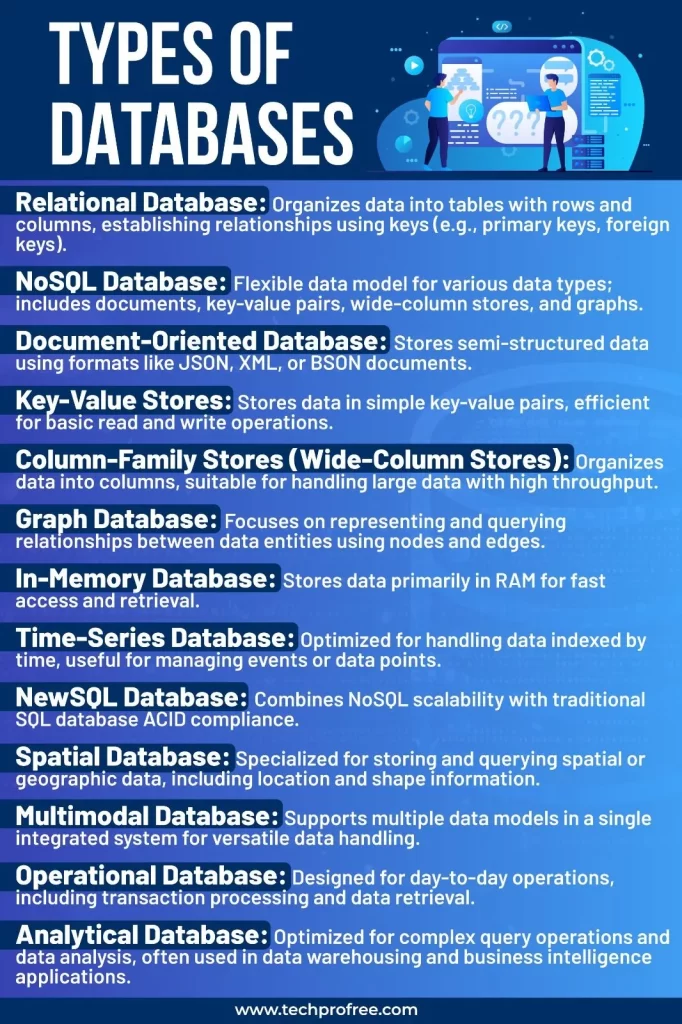
Types of DBMS Popularity
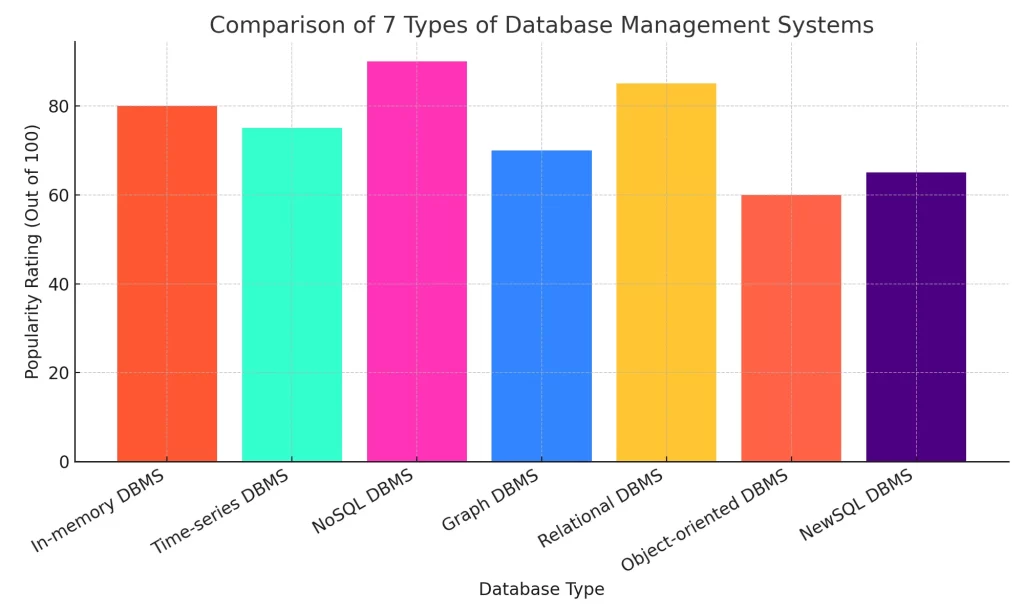
Conclusion
The constantly changing terrain of data management needs a versatile set of solutions for databases. All DBMS types, from the rigid structure there is RDBMS to the freedom of flexibility provided by NoSQL have their own strengths and weaknesses. Knowledge of these finer details enables informed choices for the management and handling of data using different industries as well as specific applications. This article has presented a preliminary survey of seven main DBMS types. With data volumes and complexities rising further, keeping tabs on innovations and upcoming DBMS solutions will be paramount to effectively understanding the changing world of data management.

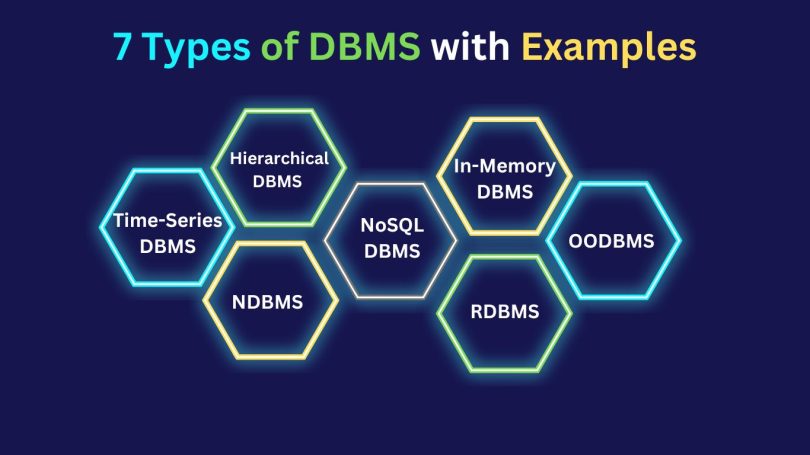
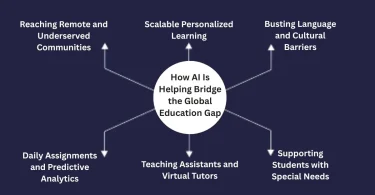
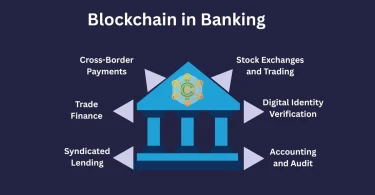
Leave a Comment